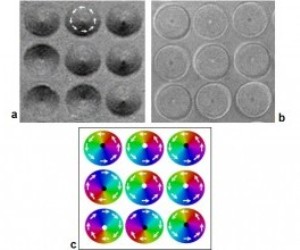Magnetic vortices in ferromagnetic disks are considered to be significant for their potential application in data storage systems based on non-volatile random access memory (RAM).
 MTXM images of in-plane (a) and out-of-plane (b) magnetic components in an array of permalloy nanodisks. In-plane magnetic rotation is shown by white arrow (a). Core polarization is marked by black (up) and white (down) spots. Image (c) shows the complete vortex configuration of each nanodisk in the array. (Images courtesy of Im and Fischer)
MTXM images of in-plane (a) and out-of-plane (b) magnetic components in an array of permalloy nanodisks. In-plane magnetic rotation is shown by white arrow (a). Core polarization is marked by black (up) and white (down) spots. Image (c) shows the complete vortex configuration of each nanodisk in the array. (Images courtesy of Im and Fischer)
A new phenomenon pertaining to the formation of magnetic vortices in ferromagnetic disks observed by researchers from the Lawrence Berkeley National Laboratory (Berkeley Lab) of the United States Department of Energy (DOE) signify that there would be challenges in implementing magnetic vortex based RAMs.
Magnetic vortices are comparable to hurricanes and are generated in ferromagnetic disks due to the spin of electrons taking the shape of the disk in order to facilitate closure of the magnetic flux lines. The subsequent curling of the magnetic flux lines in the plane is accompanied by a pointed core akin to the eye of a hurricane. The core is perpendicular to the plane of the nanodisk surface. The ferromagnetic disk is considered to comprise of two components of magnetization, namely, the upward or downward polarity of the needle core and the clockwise or anti-clockwise chirality or rotation of the in-plane magnetization. The resulting four independent orientations are considered suitable for binary data storage in non-volatile RAMs as it is assumed that the four states are symmetrical owing to energy being equivalent. It has not been possible to observe both polarity and chirality of nanodisks simultaneously. The team at Berkeley Lab was able to achieve this simultaneous observation in permalloy nanodisks by using XM-1 x-ray microscope. The team found that magnetic vortices formation is an asymmetric phenomenon and would necessitate extensive verification processes to correct errors if applied to data storage applications. They attribute the symmetry breaking to the intrinsic factor of asymmetric coupling between two electron spins known as Dzyaloshinskii–Moriya interaction and the extrinsic factor of defects along the nanodisk surface.